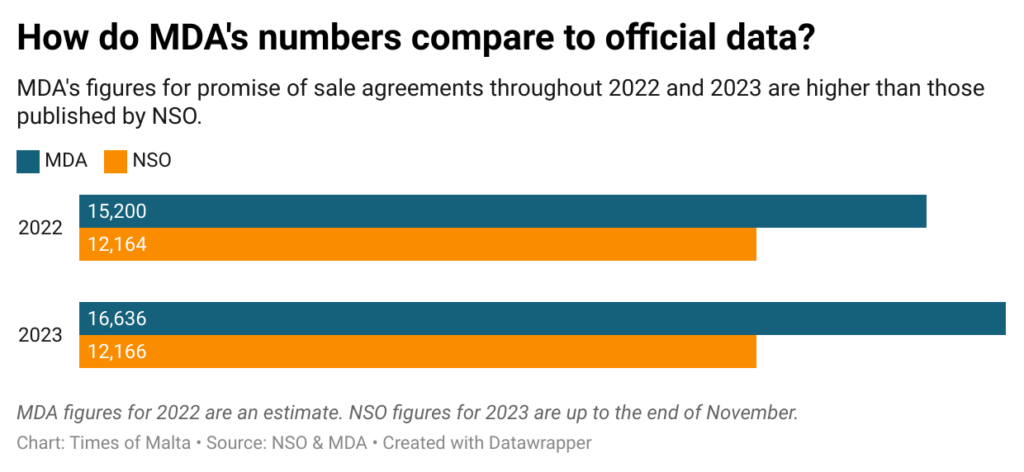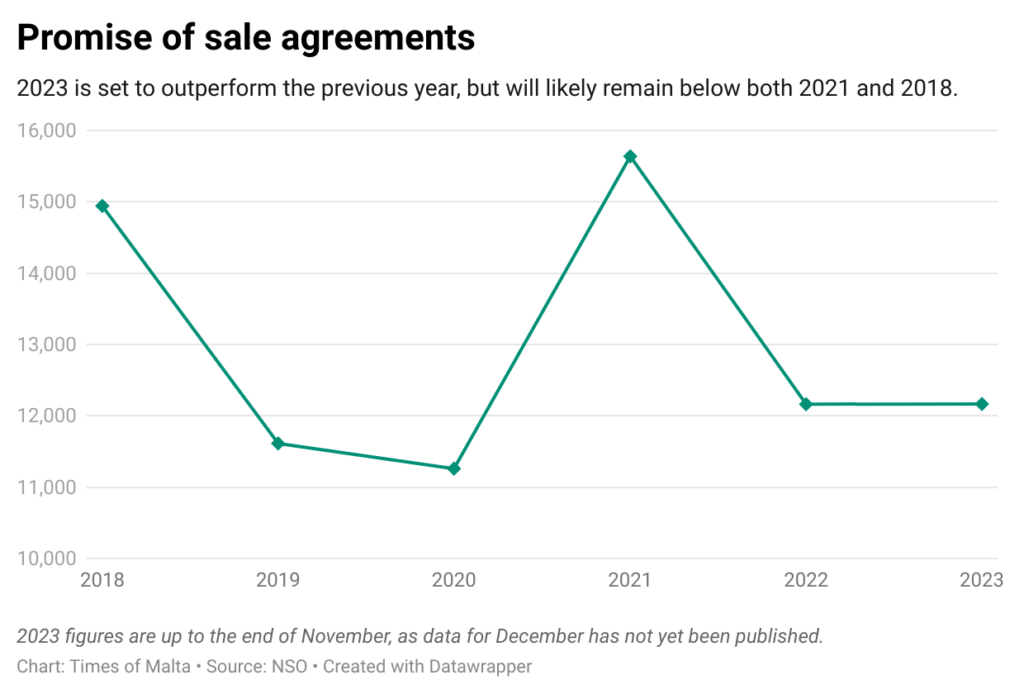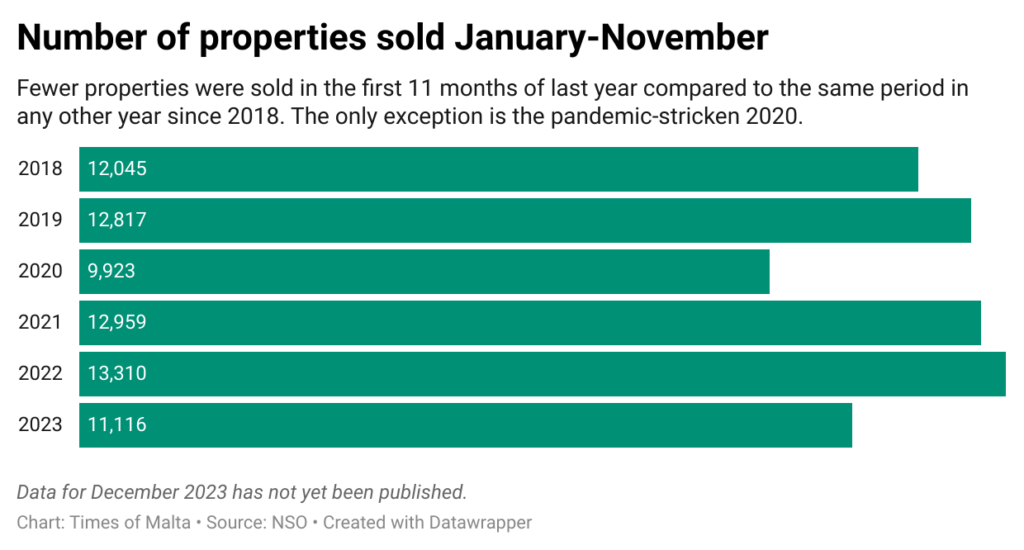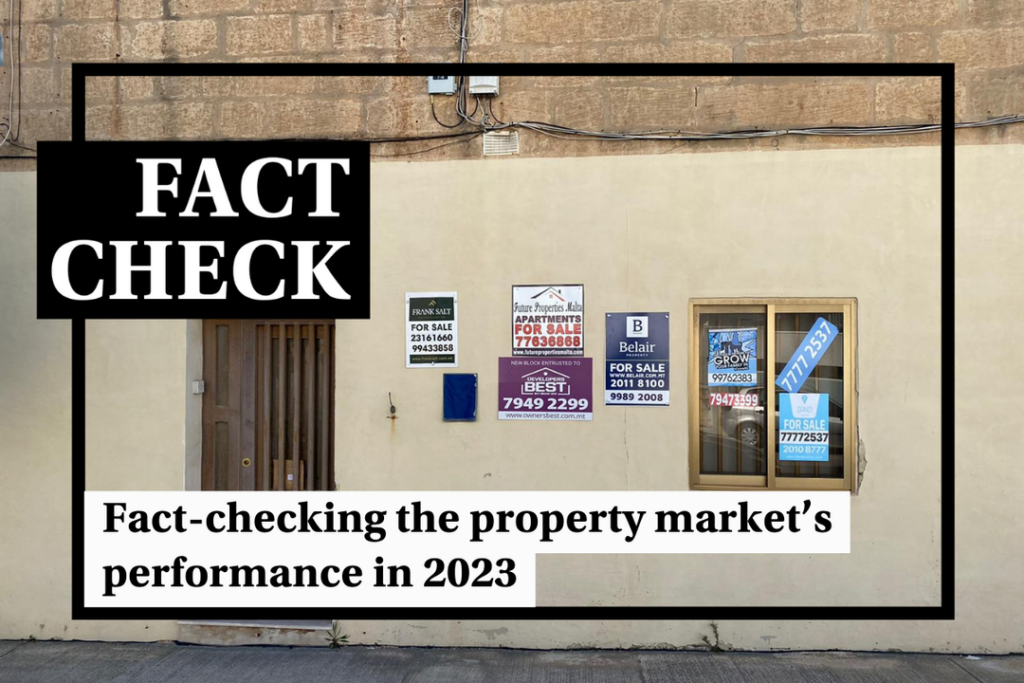The Malta Development Association (MDA), a lobby group made of many of the country’s top building developers, claimed that 2023 was the property market’s “second-best year ever”, in a statement published on January 3, saying that the number of promise of sale agreements has shot up over the past year.
A promise of sale agreement is a legal contract that is signed once the buyer and a seller agree on a price of the sale, setting out the terms of the sale and giving both parties time to raise money for the transaction (by applying for a mortgage, for instance) and sort out the necessary paperwork.
MDA say that its data “confirms the resilience of the property market”, adding that “property remains the investment of choice” for Maltese families.
The statement led to some raised eyebrows, with several readers expressing their scepticism over MDA’s figures. Some readers pointed to data that appears to suggest a slowdown in the property sector, asking Times of Malta to verify whether MDA’s data is in line with official sources.
What’s different between MDA’s numbers and official data?
MDA say that promise of sale agreements increased by some 9% in 2023 to reach 16,636. This suggests that there were just over 15,200 agreements in 2022, according to their data.
Both these figures are far higher than the figures published by the National Statistics Office (NSO), which show that there were 12,164 promise of sale agreements in 2022 and virtually the same number, 12,166, in the first 11 months of 2023.
NSO has not yet published its data for December 2023, making it impossible to know the exact number for the full year.

But this means that there would need to have been almost 4,500 agreements registered in December alone to reach MDA’s tally for the year.
This is almost unheard of. It would be more than four times higher than during any other month this year and significantly higher than any single month since the beginning of 2018. By way of comparison, just over 1,000 agreements were signed in December 2022.
Meanwhile, MDA say that the total value of the promise of sale agreements was of €4.2 billion in 2022 and €4.6 billion in 2023, only slightly less than the high of €4.8 billion recorded in 2021.
NSO, on the other hand, don’t publish the value of promise of sale agreements, instead opting to just issue that of properties that are actually sold throughout the year.
According to NSO, €3.3 billion worth of property was sold in 2022, and just over €2.9 billion in the first 11 months of 2023.
Again, NSO figures for December are not yet available, but comparing 2023’s numbers to the same periods in previous years suggests that last year was in line with both 2021 and 2022.
Why are these numbers different?
This could be down to the two organisations collecting or classifying data in different ways and choosing exclude different types of properties from their tallies.
But it’s difficult to tell whether this is the case, since MDA keep their methods under wraps and do not list their sources when publishing the data.
On the other hand, NSO’s website lays out their process in some detail, explaining that they obtain their data from tax authorities and then clean the data to remove duplicates, errors, and exclude properties that are not considered residential.
In practice, NSO’s data includes all types of residential properties, from houses and apartments to farmhouses and boathouses. It also includes transactions to buy vacant plots of land and airspaces upon which residential properties could potentially be built.
However, it doesn’t include transactions for commercial properties, such as warehouses and storerooms. It also excludes properties that are neither residential nor commercial, such as graves, fields and car parking spaces, for instance.
It isn’t clear whether MDA’s data also filters out these kinds of properties. The source of MDA’s data is also unknown and the association does not explain what measures it takes to make sure that any potential duplicates or errors in its data are flagged.
When asked to clarify these issues by Times of Malta, MDA chose not to respond.
So, was last year really the property market’s second-best ever?
It depends on what data you choose to consider and what you choose to ignore.
In simple terms, it’s true that there were more promise of sale agreements registered in 2023 compared to most years, but the number of actual property sales has dropped.
MDA’s statement only focused on the number of promise of sale agreements but did not include any data about the number of properties that were actually sold.
According to NSO figures, there were more promise of sale agreements in the first 11 months of 2023 than during the same period in either 2019, 2020 or 2022, but fewer than in 2018 or 2021.

Official data also shows that fewer properties were sold between January and the end of November 2023 compared to the same period in any other year since 2018. The only exception to this is the pandemic-stricken 2020.

Meanwhile, the number of planning permits issued also seems to have dipped slightly during the first three quarters of last year compared to the same period in 2022.
Just over 6,800 planning permits were issued in the first nine months of 2023, almost 1,000 fewer than during the same period the previous year.
This difference can be attributed to the first three months of 2022, a period coinciding with the run-up to that year’s general election, in which roughly 1,000 more planning permits were issued than during any other quarter that year.
Red tape causing delays, developers say
Developers have long argued that although property sales are down, the number of promise of sale agreements being signed shows that the industry is thriving.
The unusual situation, they say, is down to excessive red tape slowing the construction sector to a crawl, causing huge delays and forcing buyers to extend promise of sale agreements rather than finalise the purchase.
Estate agents agree, saying that while the number of promise of sale agreements falling through has dropped from one-fifth to just over one in ten, over half of all agreements are now being extended, often multiple times.

Figures show that until the end of November last year, roughly 91% of promise of sale agreements were converted into actual sales, a similar ratio to that recorded in 2018 and 2021. While this is lower than in 2022 and 2019, in which property sales registered actually outnumbered promise of sale agreements, last year’s ratio is similar to several other years, including 2018 and 2021.
There is a caveat to this data. Many promise of sale agreements only turn into a property purchase several months or even years down the line, so a fair share of property purchases registered in 2023 are likely to have been for deals agreed upon in previous years.
Verdict
The data published by MDA does not tally with official statistics, showing a far higher number of promise of sale agreements.
This difference could be down to differences in the way MDA and official authorities collect and classify their data. It is not possible to verify this as MDA do not explain their methods when publishing their data. When asked to clarify how they compile their figures, MDA chose not to reply.
A fuller picture of the property sector’s performance can be gleaned by looking beyond just the number of promise of sale agreements.
Nonetheless, official data shows that 2023 was a strong year for promise of sale agreements, trailing 2018 and 2021 but ahead of both 2020 and 2022.
On the other hand, the number of final deeds being registered continues to drop to its lowest level since 2018, except for the Covid-hit 2020.
The number of planning permits issued also appears to have dipped slightly in 2023, compared to the previous year.
The Times of Malta fact-checking service forms part of the Mediterranean Digital Media Observatory (MedDMO) and the European Digital Media Observatory (EDMO), an independent observatory with hubs across all 27 EU member states that is funded by the EU’s Digital Europe programme. Fact-checks are based on our code of principles.
Let us know what you would like us to fact-check, understand our ratings system or see our answers to Frequently Asked Questions about the service.





